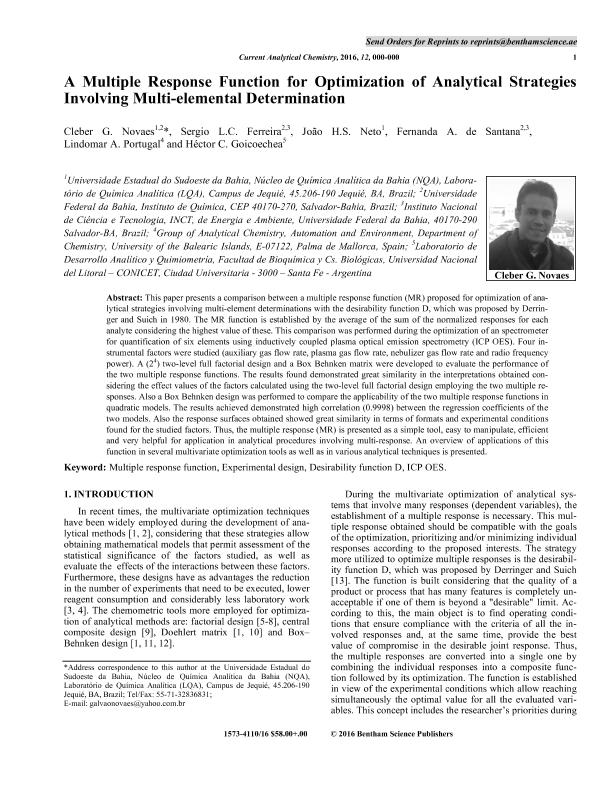Mostrar el registro sencillo del ítem
dc.contributor.author
Novaes, Cleber G.
dc.contributor.author
Ferreira, Sergio L.C.
dc.contributor.author
Neto, João H. S.
dc.contributor.author
de Santana, Fernanda A.
dc.contributor.author
Portugal, Lindomar A.
dc.contributor.author
Goicoechea, Hector Casimiro

dc.date.available
2018-08-16T19:38:02Z
dc.date.issued
2016-03
dc.identifier.citation
Novaes, Cleber G.; Ferreira, Sergio L.C.; Neto, João H. S.; de Santana, Fernanda A.; Portugal, Lindomar A.; et al.; A Multiple Response Function for Optimization of Analytical Strategies Involving Multi-elemental Determination; Bentham Science Publishers; Current Analytical Chemistry; 12; 2; 3-2016; 94-101
dc.identifier.issn
1573-4110
dc.identifier.uri
http://hdl.handle.net/11336/56003
dc.description.abstract
This paper presents a comparison between a multiple response function (MR) proposed for optimization of analyticalstrategies involving multi-element determinations with the desirability function D, which was proposed by Derringerand Suich in 1980. The MR function is established by the average of the sum of the normalized responses for eachanalyte considering the highest value of these. This comparison was performed during the optimization of an spectrometerfor quantification of six elements using inductively coupled plasma optical emission spectrometry (ICP OES). Four instrumentalfactors were studied (auxiliary gas flow rate, plasma gas flow rate, nebulizer gas flow rate and radio frequencypower). A (24) two-level full factorial design and a Box Behnken matrix were developed to evaluate the performance ofthe two multiple response functions. The results found demonstrated great similarity in the interpretations obtained consideringthe effect values of the factors calculated using the two-level full factorial design employing the two multiple responses.Also a Box Behnken design was performed to compare the applicability of the two multiple response functions inquadratic models. The results achieved demonstrated high correlation (0.9998) between the regression coefficients of thetwo models. Also the response surfaces obtained showed great similarity in terms of formats and experimental conditionsfound for the studied factors. Thus, the multiple response (MR) is presented as a simple tool, easy to manipulate, efficientand very helpful for application in analytical procedures involving multi-response. An overview of applications of thisfunction in several multivariate optimization tools as well as in various analytical techniques is presented.
dc.format
application/pdf
dc.language.iso
eng
dc.publisher
Bentham Science Publishers

dc.rights
info:eu-repo/semantics/openAccess
dc.rights.uri
https://creativecommons.org/licenses/by-nc-sa/2.5/ar/
dc.subject
Multiple Response Function
dc.subject
Experimental Design
dc.subject
Desirability Function D
dc.subject
Icp Oes
dc.subject.classification
Otras Ciencias Químicas

dc.subject.classification
Ciencias Químicas

dc.subject.classification
CIENCIAS NATURALES Y EXACTAS

dc.title
A Multiple Response Function for Optimization of Analytical Strategies Involving Multi-elemental Determination
dc.type
info:eu-repo/semantics/article
dc.type
info:ar-repo/semantics/artículo
dc.type
info:eu-repo/semantics/publishedVersion
dc.date.updated
2018-08-16T17:37:40Z
dc.journal.volume
12
dc.journal.number
2
dc.journal.pagination
94-101
dc.journal.pais
Estados Unidos

dc.journal.ciudad
Oak Park
dc.description.fil
Fil: Novaes, Cleber G.. Universidade Estadual do Sudoeste da Bahia; Brasil. Universidade Federal da Bahia; Brasil
dc.description.fil
Fil: Ferreira, Sergio L.C.. Universidade Federal da Bahia; Brasil
dc.description.fil
Fil: Neto, João H. S.. Universidade Estadual do Sudoeste da Bahia; Brasil
dc.description.fil
Fil: de Santana, Fernanda A.. Universidade Federal da Bahia; Brasil
dc.description.fil
Fil: Portugal, Lindomar A.. Universidad de las Islas Baleares; España
dc.description.fil
Fil: Goicoechea, Hector Casimiro. Consejo Nacional de Investigaciones Científicas y Técnicas; Argentina. Universidad Nacional del Litoral. Facultad de Bioquímica y Ciencias Biológicas; Argentina
dc.journal.title
Current Analytical Chemistry

dc.relation.alternativeid
info:eu-repo/semantics/altIdentifier/doi/https://dx.doi.org/10.2174/1573411011666150722220335
dc.relation.alternativeid
info:eu-repo/semantics/altIdentifier/url/http://www.eurekaselect.com/133390/article
Archivos asociados
